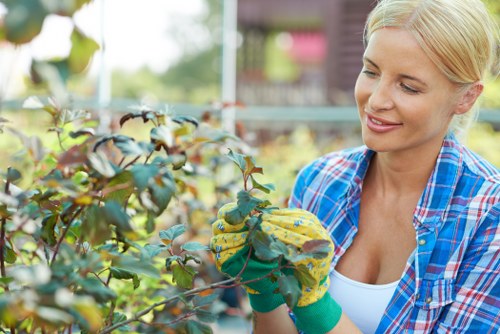Tree Lopping and Removal in Poplar
Understanding Poplar Trees

Poplar trees are known for their rapid growth and striking appearance. They are commonly found in parks, gardens, and along streets due to their ability to provide ample shade and ornamental value.
However, despite their benefits, poplar trees can sometimes become a maintenance challenge. Issues such as disease, structural instability, or invasive roots may necessitate tree lopping and removal.
Proper management of poplar trees ensures the safety of your property and the health of your landscape. Understanding when and how to proceed with tree lopping and removal is crucial.
Signs Your Poplar Tree Needs Lopping or Removal

Identifying the right time to lop or remove a poplar tree can prevent potential hazards. Here are key indicators:
- Dead or Diseased Branches: Presence of deadwood can lead to structural weaknesses.
- Overcrowding: Excessive growth can interfere with nearby structures or other trees.
- Root Problems: Invasive roots may damage pavements, foundations, or underground utilities.
- Lean or Instability: A tree that leans significantly or sways excessively may pose a risk during storms.
Tree Lopping vs. Tree Removal

It's essential to differentiate between tree lopping and tree removal to choose the appropriate action:
- Tree Lopping: Involves pruning or cutting back branches to manage shape, size, or health.
- Tree Removal: Entails completely taking down the tree, usually when it's beyond recovery or poses a safety threat.
Consulting with a professional arborist can help determine the best course of action based on the tree's condition.
Benefits of Professional Tree Lopping and Removal

Hiring experts for tree lopping and removal offers several advantages:
- Safety: Professionals have the right equipment and expertise to handle dangerous tasks.
- Efficiency: Experienced arborists can perform the job quickly and effectively.
- Health Assessment: Experts can identify underlying issues and provide appropriate care or solutions.
- Regulatory Compliance: Professionals ensure that all local laws and regulations are followed during the process.
Investing in professional services can save time, money, and potential headaches in the long run.
Steps Involved in Tree Removal

Removing a poplar tree is a complex process that requires careful planning and execution. Here are the typical steps involved:
- Assessment: Inspect the tree and surrounding area to determine the best removal strategy.
- Permitting: Obtain necessary permits from local authorities if required.
- Preparation: Clear the area of obstacles and ensure safety measures are in place.
- Cutting: Carefully remove branches and lower the tree in sections.
- Cleanup: Remove all debris and ensure the site is clean.
- Stump Grinding: Grind down the stump to prevent regrowth and improve aesthetics.
Each step requires expertise to ensure the tree is removed safely and efficiently.
Cost Factors for Tree Lopping and Removal
The cost of tree lopping and removal in Poplar can vary based on several factors:
- Tree Size: Larger trees require more labor and equipment, increasing costs.
- Accessibility: Trees in hard-to-reach areas may require specialized equipment.
- Health of the Tree: Diseased or damaged trees may need additional care.
- Location: Proximity to structures or power lines can impact the complexity of the job.
- Additional Services: Stump removal, debris hauling, and cleanup services can add to the total cost.
Obtaining multiple quotes from reputable service providers can help ensure you receive a fair price.
Environmental Considerations
While tree removal is sometimes necessary, it's important to consider the environmental impact:
- Habitat Disruption: Trees provide habitats for various species; removal can affect local biodiversity.
- Carbon Sequestration: Trees absorb carbon dioxide, contributing to oxygen production and climate regulation.
- Soil Stability: Tree roots help prevent soil erosion and maintain soil health.
Whenever possible, consider alternatives such as tree lopping or rehabilitating the tree to preserve its environmental benefits.
Post-Removal Care and Landscape Restoration
After tree removal, proper care can help restore your landscape:
- Soil Treatment: Address any soil damage or erosion caused by the tree’s removal.
- Planting New Trees: Replace removed trees with new ones to maintain your landscape’s aesthetic and environmental quality.
- Landscaping: Update garden beds, lawns, and other landscape features to integrate the space seamlessly.
- Maintenance: Regular upkeep ensures the health and beauty of your new or remaining trees.
Engaging with landscaping professionals can facilitate a smooth transition and enhance your property’s overall appeal.
Choosing the Right Tree Service Provider
Selecting a reputable tree service provider is essential for quality tree lopping and removal in Poplar:
- Experience: Look for companies with a proven track record and expertise in handling poplar trees.
- Licensing and Insurance: Ensure the provider is licensed and insured to protect against potential liabilities.
- Customer Reviews: Check testimonials and reviews to gauge customer satisfaction.
- Transparent Pricing: Choose providers who offer clear and detailed quotes without hidden fees.
- Safety Standards: Verify that the company adheres to industry safety protocols and best practices.
Taking the time to research and select a trustworthy provider ensures a successful and hassle-free experience.
Seasonal Considerations for Tree Removal
Timing plays a significant role in the effectiveness of tree removal:
- Dormant Season: Late fall or winter is ideal as trees are less active, reducing sap loss and making structural assessment easier.
- Weather Conditions: Avoid scheduling removal during extreme weather to ensure safety and efficiency.
- Growth Cycles: Understanding the tree’s growth patterns can help in planning and minimizing disruption.
Consulting with arborists can help determine the best time for tree removal based on your specific circumstances.
Legal and Regulatory Compliance
Tree lopping and removal often involve adhering to local laws and regulations:
- Permits: Depending on the size and location of the tree, permits may be required.
- Protected Species: Some trees may be protected species, restricting or regulating their removal.
- Homeowners’ Associations: If you live in an HOA, check for any rules or guidelines regarding tree removal.
- Neighbor Considerations: Ensure that tree removal does not negatively impact neighboring properties.
Compliance with all legal requirements avoids potential fines and legal issues, ensuring a smooth process.
The Role of Arborists in Tree Removal
Certified arborists play a crucial role in tree lopping and removal:
- Expert Assessment: Arborists evaluate the tree’s health and structural integrity.
- Strategic Planning: They develop a plan that minimizes risk and environmental impact.
- Execution: Arborists use specialized equipment and techniques to safely remove or lop trees.
- Aftercare: They provide guidance on post-removal landscape restoration and tree care.
Hiring a professional arborist ensures that the job is done correctly and responsibly.
Preventative Measures to Reduce Tree Maintenance
Maintaining tree health can minimize the need for extensive lopping or removal:
- Regular Pruning: Trim branches to promote healthy growth and prevent structural issues.
- Proper Watering: Ensure trees receive adequate water, especially during dry periods.
- Soil Health: Fertilize and aerate soil to support robust root systems.
- Integrated Pest Management: Monitor and address pest infestations promptly.
Implementing these measures can extend the lifespan of your poplar trees and reduce maintenance efforts.
Innovations in Tree Removal Technology
Advancements in technology have enhanced the efficiency and safety of tree removal:
- Aerial Lifting Equipment: Allows access to difficult areas without extensive ground operations.
- Stump Grinding Machines: Efficiently remove stumps, preventing regrowth.
- Safety Gear: Modern protective equipment ensures the safety of workers.
- Software Tools: Planning and simulation software helps in strategizing the removal process.
Utilizing the latest technology improves outcomes and reduces the environmental footprint of tree removal activities.
Case Studies: Successful Tree Removal Projects
Reviewing past projects can provide insights into effective tree removal strategies:
- Urban Property: Removal of a large poplar tree near power lines using aerial lifting to ensure safety.
- Residential Garden: Comprehensive lopping to restore tree health and enhance landscape aesthetics.
- Commercial Site: Efficient removal and stump grinding to prepare the area for new construction.
These examples demonstrate the importance of tailored approaches to meet specific needs and challenges.
Frequently Asked Questions
Addressing common concerns about tree lopping and removal:
Is Tree Removal Always Necessary?
No, tree removal is not always necessary. In many cases, tree lopping or pruning can address issues without the need for complete removal.
How Long Does the Removal Process Take?
The duration depends on the tree’s size, health, and location. Smaller trees may be removed in a few hours, while larger or more complex removals can take longer.
What Should I Do After a Tree is Removed?
Consider soil treatment, landscape restoration, and planting new trees to maintain your property’s aesthetic and environmental balance.
Conclusion
Tree lopping and removal in Poplar is a significant task that requires careful consideration and professional expertise. Understanding the signs that indicate the need for intervention, choosing the right service provider, and adhering to environmental and legal guidelines are paramount for successful outcomes.
Whether you need to enhance your property's safety, improve its aesthetic appeal, or address specific tree health issues, professional tree services offer the knowledge and tools necessary to achieve your goals effectively.
Don’t wait until a small issue becomes a major problem. Contact us today to schedule a consultation and ensure the health and safety of your poplar trees.
Get Started with Your Tree Removal Project
Ready to take the next step? Book your service now and let our experts handle all your tree lopping and removal needs with precision and care.